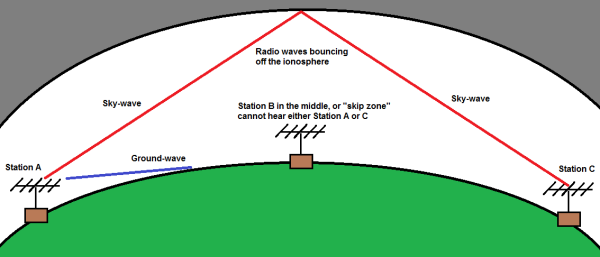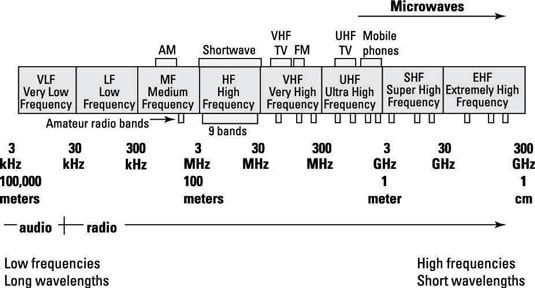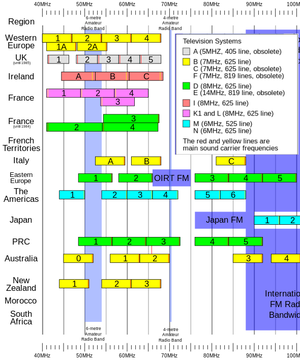The HF bands are by far the most popular bands in the amateur service. Not actually a Ham Band but a cluster of 5 frequencies or channels shared with Government users.
Mixed between the shortwave bands above are many hf ham radio bands where you can hear ham radio operators from all over the world conversing back and forth.

Ham radio bands explained. Ham radio bands summaries 136 kHz LF band HF bands VHF bands UHF bands. The NCDXF beacon call sign and the first dash is sent at 100Watts. Common Ham Radio Q Signals Hams use three-letter Q signals on every mode and even in face-to-face conversation.
For the HF bands the frequency privileges depend greatly on the license class of the operator. Entire amateur radio band 4 mm. The remaining dashes are sent at 10Watts 1 Watt and 01 Watts.
The convention used by hams is that bands above the 30-meter band frequencies greater than 10 MHz including all VHF and UHF bands use the upper sideband USB the band of frequencies adjacent to and higher than the carrier frequency. Band Plans and information The RSGB Band Plans are normally published annually in the February edition of RadCom and additionally reviewed mid-year. The UHF amateur radio bands provide a unique opportunity for many contacts to be made.
The Radio Prepper logo depicting a microphone is indeed in. In general contacts tend to be over distances of 30 miles or more but on occasions signals may travel over much greater distances. These ham radio bands or frequency allocations are open to radio hams around the world to use although the actual ham radio allocations do vary slightly from country to country and region to region.
The Northern California DX Foundation operates eighteen ham radio beacons on five continents which transmit in successive one-minute intervals on 14100 18110 21150 24930 and 28200 MHz. For bands below 30-meters frequencies lower than 10 MHz the lower sideband is used. Terrestrial Weak Signal Band Future Note 2 3400100.
Secondary Entire amateur radio band 248000 GHz - 250000 GHz. They consist of 30 meters 1010010150 MHz 17 meters 1806818168 MHz and 12 meters 2489024990 MHz. For specific characteristics of each band click on the links below.
The HF Bands - For HF Newcomers - The HF ham bands can be mysterious. Some seem to be good for long distance contacts while some are better for nearby contacts. Local contacts and world-wide propagation are all possible at almost anytime with careful selection of the right frequency for the time of day time of year and current state of the sunspot cycle.
It is derived from the IARU Region 1 Band Plans taking into account any proposed national variations or special amendments which are considered necessary by the relevant spectrum manager. Analog Digital including Full Duplex 10 MHz. Above 50 MHz the frequency allocations are the same for Technician licenses and higher.
Analog Digital including Full Duplex. Here are the Q signals most commonly used in day-to-day operation. 241000 GHz - 248000 GHz.
Hams are secondary user of this band not primary so we must yield to interference problems with Government stations. The HF bands are by far the most popular bands in the amateur service. Not all bands have been assigned a letter by AMSAT.
The WARC bands 30m 17m 12m are so-called due to their inclusion in the Amateur Radio bandplan during the W orld A dministrative R adio C onference in 1979 and are free of contest activity Thereby offering a safe sanctuary from those who prefer a longer QSO or wish to find a more challenging DX contact. In particular the 2m band extends from 144 MHz to 148 MHz. Each signal can be a question or an answer as shown in the Meaning column.
3 kHz or less. Secondary 77500 GHz - 78000 GHz. 60 meters is much like 80 and 40 meters.
Primary Entire amateur radio band 136000 GHz - 141000 GHz. The World Administrative Radio Conference WARC bands are three portions of the shortwave radio spectrum used by licensed andor certified amateur radio operators. Explanation of terminology and technology used in survival radio.
UHF ham radio bands. Read more about UHF ham radio bands. Many restrictions apply to technical requirements of ham transmitters and antennas.
Some work at night some during the day. The Ham Amateur Radio bands. Even worse they change tremendously from hour to hour and day to day.
76000 GHz - 77500 GHz. There is a good variety of ham bands or amateur radio allocations within the HF portion of the short wave spectrum. Weak Signal EME Band 3400300.
Rod K8RR and Mark W8BBQ discuss the different amateur radio bands and frequencies including HF UHF and VHF bands. Ham Radio Beacon Frequencies. Primary 1 AMSAT band letters.
Local contacts and world-wide propagation are all possible at almost anytime with careful selection of the right frequency for the time of day time of year and current state of the sunspot cycle. For specific characteristics of each band click on the links below. 134000 GHz - 136000 GHz.
You can sometimes hear emergency communications going on from all parts of the world. Primary 78000 GHz - 81000 GHz.
 All About Ham Radio News Sparkfun Electronics
All About Ham Radio News Sparkfun Electronics
 Here S How The Wireless Spectrum Is Divided Up In The Us World Economic Forum
Here S How The Wireless Spectrum Is Divided Up In The Us World Economic Forum
 Ft8 Saving Ham Radio Or Killing It Hackaday
Ft8 Saving Ham Radio Or Killing It Hackaday
 Beginners Guide To Ham Radio Make Your Own Eagle Blog
Beginners Guide To Ham Radio Make Your Own Eagle Blog
 Beginners Guide To Ham Radio Make Your Own Eagle Blog
Beginners Guide To Ham Radio Make Your Own Eagle Blog
 Introduction To Hf Part 1 Of 3 The Hf Bands Essex Ham
Introduction To Hf Part 1 Of 3 The Hf Bands Essex Ham
 Amateur Radio Tools Icom America
Amateur Radio Tools Icom America
 How To Use A Ham Radio How To Demonstrate Ham Radio Bands Youtube
How To Use A Ham Radio How To Demonstrate Ham Radio Bands Youtube
 What Are Radio Frequency Bands And Its Uses Rf Page
What Are Radio Frequency Bands And Its Uses Rf Page
 Amateur Radio Bands And Frequencies Explained
Amateur Radio Bands And Frequencies Explained
 Learning The Hf Ham Bands 10 Meters 28mhz Introduction To Hf Youtube
Learning The Hf Ham Bands 10 Meters 28mhz Introduction To Hf Youtube



